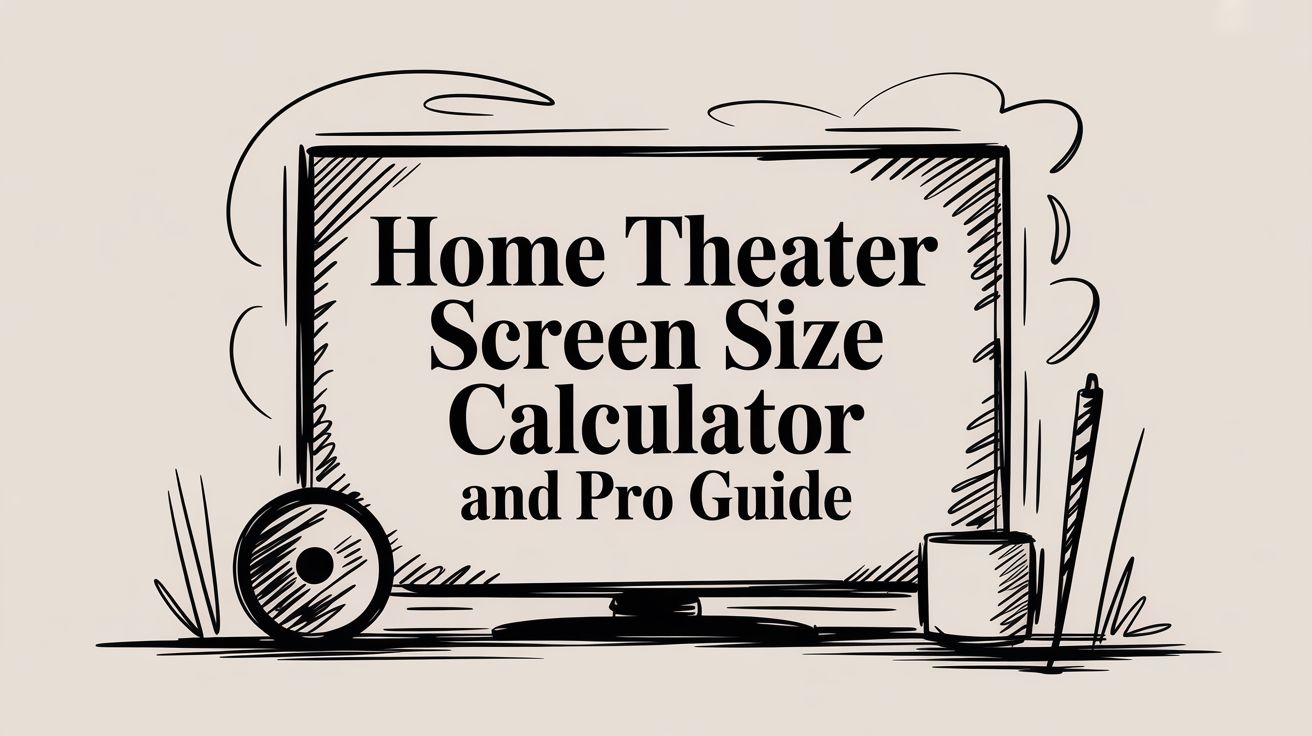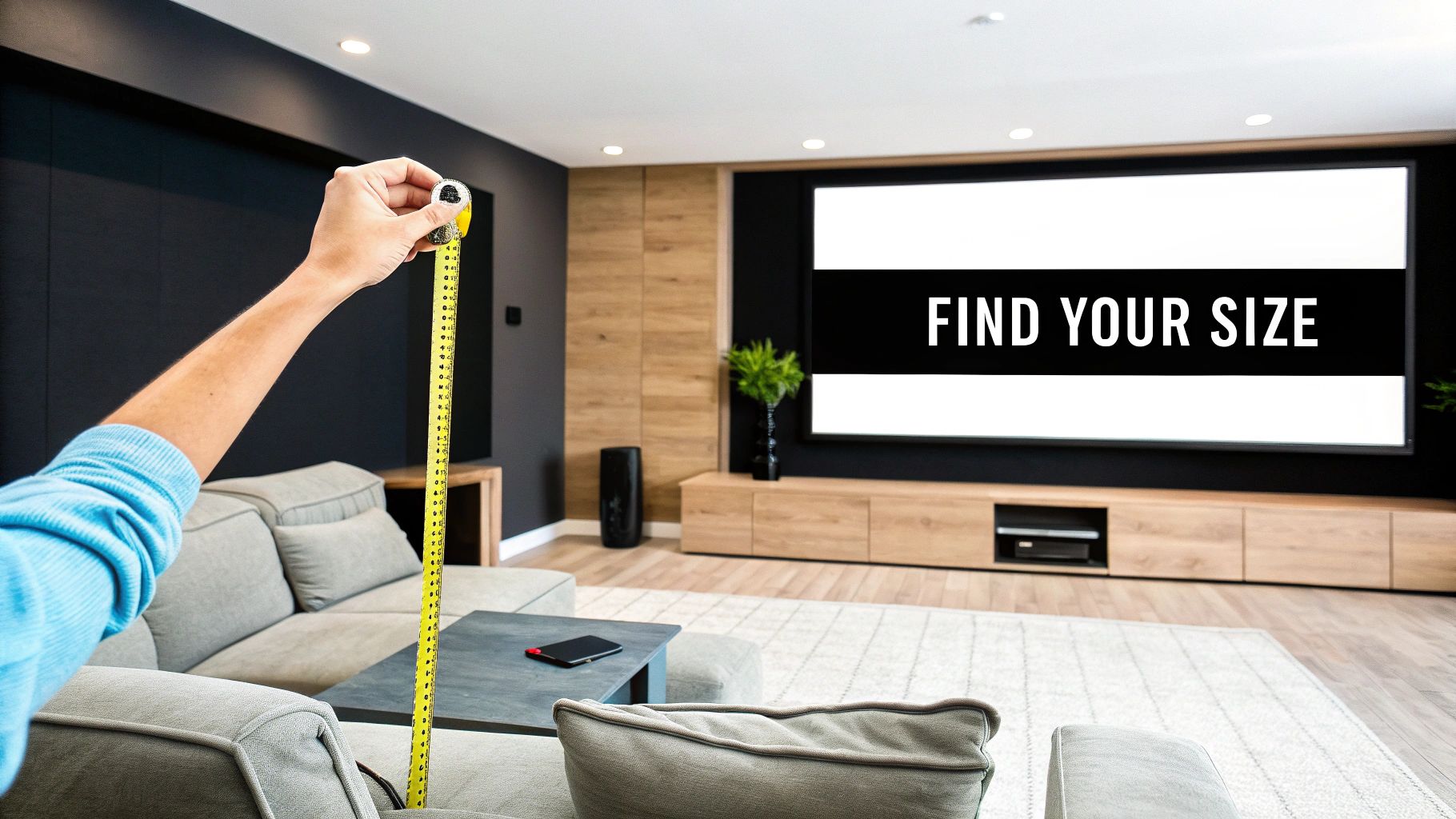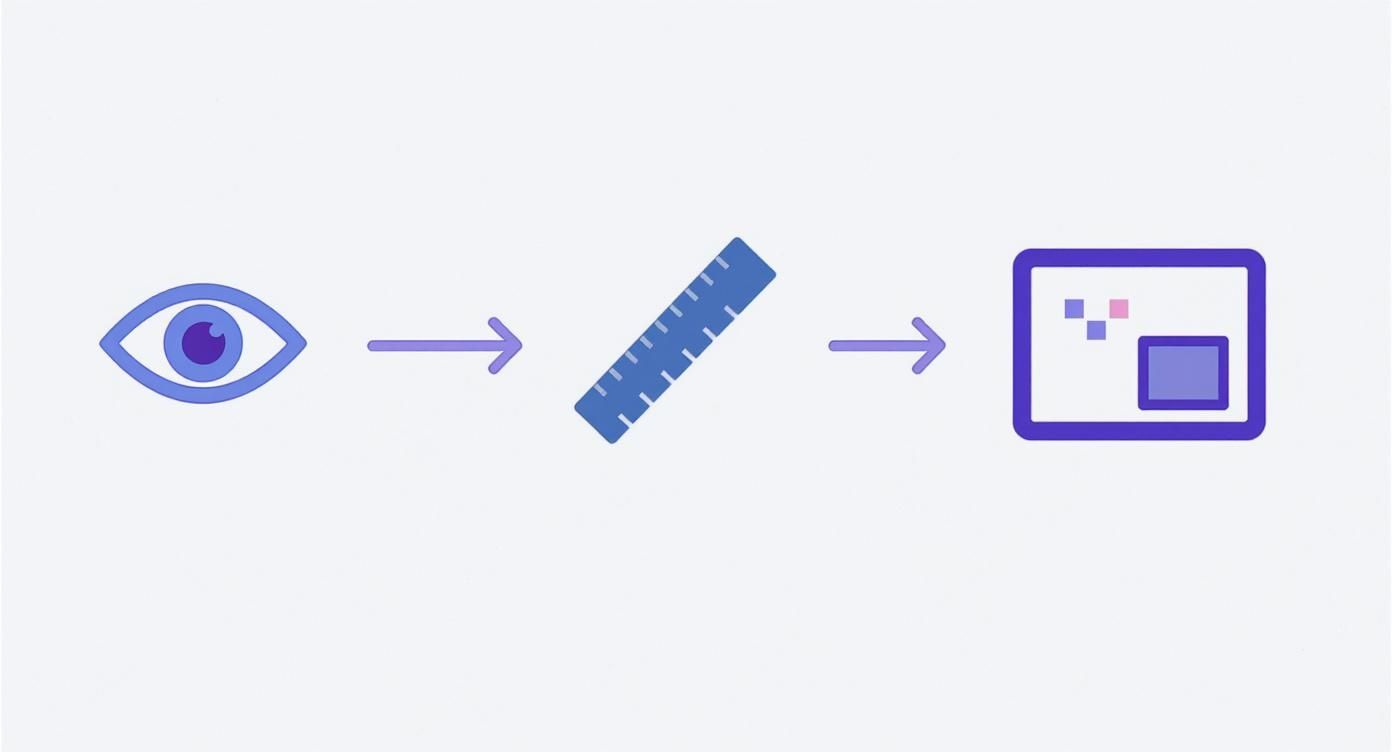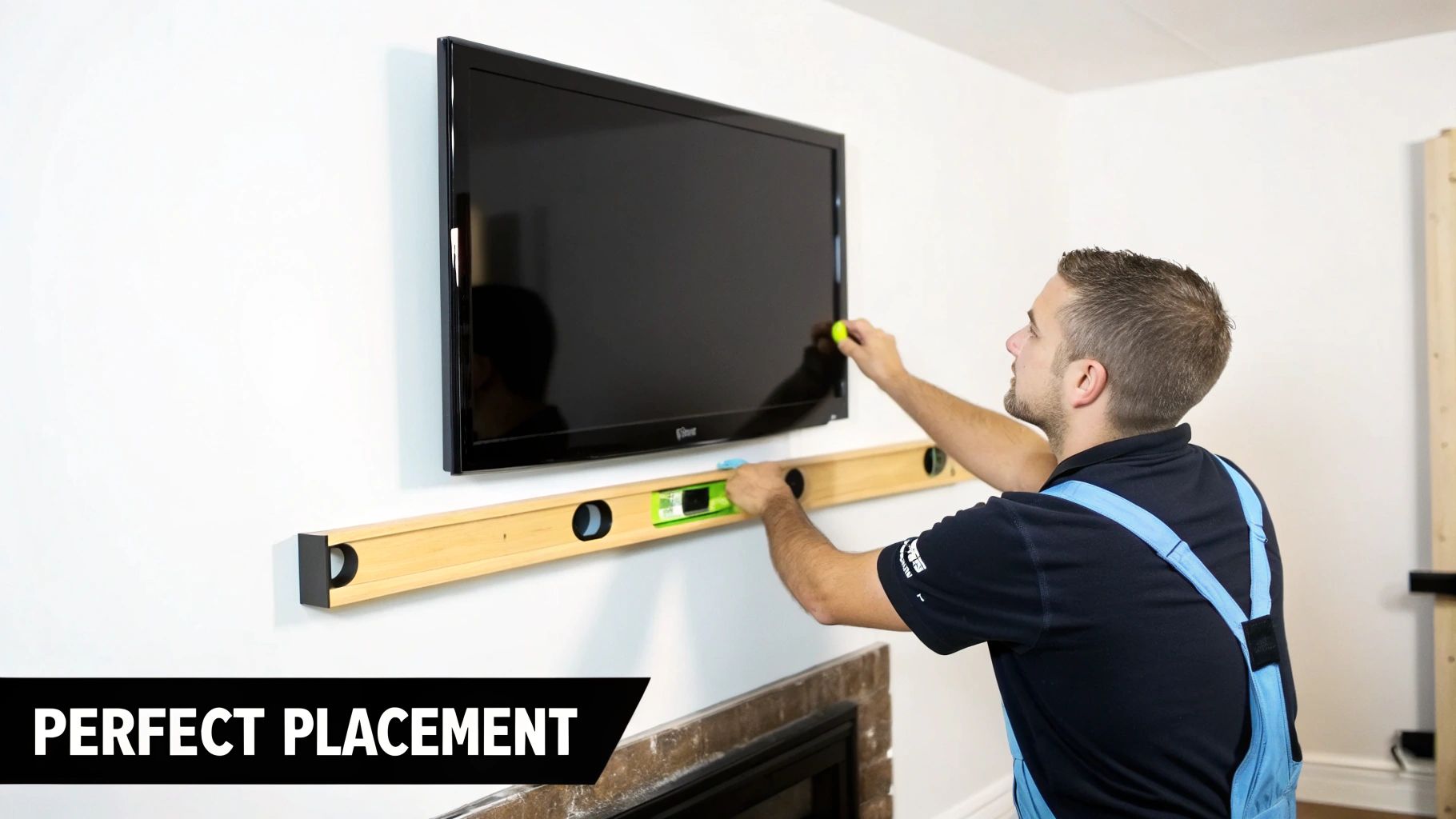
Stage with led screen: Elevate Your Event Visuals Today
Not long ago, a stage with an led screen was just a fancy backdrop. Now, it's the dynamic, beating heart of any modern live event.

Figuring out your ideal screen size can feel like a guessing game, but a simple calculation can turn that guesswork into a precise science. Here's the magic formula to start with: take your seating distance in inches, divide it by 1.6, and you'll have an excellent starting point for a 4K screen's diagonal size.
It's a straightforward piece of math that ensures you get that immersive, cinematic feel without causing eye strain.

Before we get lost in the weeds with complex angles and technical specs, let's lock down a solid, real-world baseline. The single most important factor driving your screen size decision is your viewing distance—how far your primary seat is from the wall. If you get this relationship right, everything else just falls into place.
This is where that quick calculation becomes your best friend. The standards for home theater design aren't arbitrary; they're based on careful studies to maximize visual comfort and image quality. Industry research points to a key recommendation: for 4K displays, dividing your viewing distance in inches by 1.6 gives you the sweet spot for screen size.
So, why does this simple math work so well? It all comes down to the resolving power of the human eye and the incredible pixel density of modern 4K screens. At this specific distance, the image is large enough to fill your field of view for that "wow" factor, but you're just far enough away that individual pixels melt away into a perfectly smooth picture.
The real goal is to create an experience where the technology completely disappears, leaving you with just the content. Hitting this sweet spot helps you avoid common pitfalls, like buying a screen so massive it causes neck strain, or one so small it feels less like a cinema and more like a regular TV.
To make things even easier, I've put together a table that does the math for you. Just find your approximate seating distance to get a solid recommendation for a truly cinematic 4K experience. Think of this as the perfect starting point for planning your dream setup.
| Seating Distance (Feet) | Seating Distance (Inches) | Recommended Screen Size (Diagonal Inches) |
|---|---|---|
| 8 ft | 96 inches | 60 inches |
| 10 ft | 120 inches | 75 inches |
| 12 ft | 144 inches | 90 inches |
| 15 ft | 180 inches | 112 inches |
This simple distance-based approach gives you a fantastic estimate to work from. It's the same core principle that informs the engineering behind our advanced indoor LED wall screen kits, which are designed from the ground up to deliver breathtaking clarity at specific viewing ranges.
When it comes to picking the right screen size, two factors trump all others: how far you sit from the screen and the resolution of your projector. These two are completely locked together, and getting their relationship right is the secret to avoiding a setup you'll regret. It’s not just about getting a "big" screen; it's about making sure the image looks flawless from your favorite chair.
Think of it this way: screen resolution is all about information density. A 4K screen crams four times as many pixels into the same physical area as a 1080p screen. That incredible density is what lets you sit closer and go bigger, creating that wall-to-wall immersive feeling without the image falling apart.
The goal is to hit that perfect sweet spot. You want a screen large enough to feel like a real cinema, but you need to be just far enough away that the individual pixels melt away into a single, smooth, cohesive image. That's what pulls you into the movie.
Have you ever sat in the very front row of a commercial theater? You might have noticed the image looked a little soft, almost like you could see the texture of the screen itself. That’s the "screen door effect," and it happens when you're simply too close for the projector's resolution.
The exact same thing happens at home. Sit too close to a big 1080p screen, and your eyes will start to resolve the individual pixels. Instead of a sharp image, you'll see a grid-like pattern that makes everything look blocky and robs the picture of its detail.
But the opposite is also a problem. If you sit too far back from a gorgeous 4K screen, you're essentially throwing away all that extra detail you paid for. Your eyes physically can't perceive the fine nuances, making that stunning 4K image look no better than 1080p. All that extra clarity is just wasted.
The perfect viewing distance gives you the full, breathtaking benefit of your screen's resolution without revealing the pixel structure behind it. It’s the ultimate balance between immersion and image integrity.
Let's ground this in a real-world scenario to show you just how much resolution changes the math.
Let's say your couch is exactly 10 feet (120 inches) from your screen wall. This is a pretty common distance. How does picking a 1080p vs. a 4K projector change your ideal screen size?
This shows why a simple "one-size-fits-all" chart doesn't cut it. Moving from 1080p to 4K isn't just a small step up—it fundamentally rewrites the rules of engagement, letting you get a much more cinematic experience from the exact same room. This critical relationship is exactly what a good home theater calculator is built to solve.
Simple distance formulas are a great starting point, but if you want to think like a professional cinema designer, you need to talk about viewing angles. This is the secret sauce that turns a "big TV" into a truly immersive home cinema. It’s all about how much of your field of view the screen occupies from your main seat.
Organizations like THX and the Society of Motion Picture and Television Engineers (SMPTE) have done the legwork, establishing standards based on how we actually see. Their recommendations are the gold standard for creating that captivating, theater-like pull without causing eye strain or making you scan the screen just to keep up.
These standards ensure the picture is big enough to completely draw you in. This is exactly what a good home theater screen size calculator does—it refines its recommendations using these pro-level principles, going way beyond basic math.
So, what are these magic numbers? The recommendations from the pros are surprisingly consistent, giving you a clear target for your own setup.
In practical terms, aiming for a viewing angle between 36 and 40 degrees for your main seats will deliver that professional-grade immersion you’re after. It’s the perfect balance, making the screen feel huge without becoming overwhelming.
This infographic really drives home how viewing distance plays into all of this, especially when it comes to perceiving resolution.

As you can see, a larger screen creates a wider viewing angle. To keep the image sharp and pixel-free at that size, you really need a high-resolution source like 4K.
Let's make this practical. Imagine a dedicated theater room with two rows. The "money seats" in the front are 10 feet from the screen, while the second row is back at 14 feet. Your goal is to give the front row the best possible experience while making sure the back row still feels included.
If you plug these numbers into a calculator that uses viewing angles, you'd target that 36-40 degree sweet spot for the 10-foot distance. This would likely point you toward a 120-inch screen.
From the back row, that same 120-inch screen creates a viewing angle of around 28 degrees. That's still a fantastic, engaging picture that falls comfortably within SMPTE's guidelines.
This is a strategic choice. You optimize for the primary seats without sacrificing the secondary ones. It’s a perfect example of how cinema standards have evolved with technology. Years ago, screen sizes were held back by projector brightness. Today, with powerful 4K projectors, we can finally achieve these ideal viewing angles in a home setting. You can read more about the evolution of projector screen sizes to see just how far we've come.
While the basic formulas give you a solid starting point, a proper home theater screen size calculator is where the real magic happens. It takes all the individual variables we've discussed and crunches them together to give you a recommendation that’s genuinely precise. These tools go way beyond just viewing distance, letting you dial in the specifics of your room, your gear, and how you actually watch movies.
The best calculators out there won't just ask for your seating distance. They dig deeper, getting into the nitty-gritty details that separate a "good" home theater from a truly great one.
Here are a few key inputs you'll often see:
Modern screen size calculators have come a long way. The earliest public versions popped up in the early 2000s, but today's tools use complex algorithms to balance all these factors, recommending a setup that maximizes both clarity and brightness. If you want to see one of the benchmarks that enthusiasts have relied on for years, check out this detailed home theater calculator.
The real power of an advanced calculator is its ability to model real-world situations. Let's look at two completely different rooms to see how this plays out.
Scenario 1: The Dedicated Basement Theater
In a purpose-built, light-controlled room, you have the advantage. You can push the screen size to the max and opt for a lower-gain screen material because you aren't fighting any stray light. A good calculator will see this and likely steer you toward the largest screen possible based on THX viewing angles for your seat.
Scenario 2: The Bright, Multi-Use Living Room
Now, throw some windows and lamps into the mix. A multi-purpose living room completely changes the equation. The calculator's algorithm will start weighing things like screen gain—a measure of its reflectivity—and projector brightness much more heavily. It might suggest a slightly smaller screen, but one with a higher gain to create a punchy, vibrant image that can cut through the ambient light.
This is exactly what a well-designed calculator interface looks like. It lets you tweak every single variable.
See how it accounts for everything from screen material to the specific projector model? That's how you get a truly precise result.
When you input these advanced details, you're not just getting a generic size anymore. You’re getting a solution engineered for your specific environment. This data-driven approach takes the guesswork out of the equation and ensures you get the absolute best performance from your investment.

You’ve run the numbers and figured out the perfect screen size for your room. That's a huge step, but the job isn't done. Now comes the part that can make or break your entire setup: installation.
Getting the placement right is just as important as the size itself. I’ve seen countless amazing screens undermined by poor positioning, leading to everything from a stiff neck to a completely disjointed viewing experience.
The single most common mistake? Mounting the screen way too high. It's a habit people pick up from hanging pictures or sticking a TV above the fireplace mantle. But for a true home theater, you need to think differently. The goal is to have the bottom third of the screen sitting right around eye level when you're in your favorite chair. This creates a natural, relaxed posture that’s essential for getting through a three-hour movie without feeling it in your neck.
Here's a simple trick I tell all my clients: Sit in your main viewing spot and look straight ahead, completely relaxed. The center of your screen should land at or just below your direct line of sight. This ergonomic sweet spot is the secret to long-term comfort.
Once you’ve nailed the vertical height, it's time to think horizontally. Your first instinct might be to center the screen on the wall, but hold on. The real center is your primary seating position. If your couch is off to one side of the room, your screen should be too. It might look a little strange at first, but it guarantees the best possible viewing angle for the main seats.
Another piece of the puzzle is your audio. Your front soundstage—the left, right, and center channel speakers—is the heart of your surround sound system.
When you manage these elements carefully, your audio and video start working together in perfect harmony. It’s this attention to detail that separates a good setup from a truly professional one, especially with advanced displays like Smart LED indoor LED wall panels, where precise alignment is non-negotiable for a seamless picture.
And don't forget the room itself. Things like optimizing room paint colors for viewing can make a surprising difference by cutting down on distracting reflections and pulling you deeper into the action.
Even with the best tools, a few nagging questions always seem to surface right before you pull the trigger on a new screen. A home theater screen size calculator gets you most of the way there, but it’s understanding the why behind the numbers that gives you real confidence.
Let's break down some of the most common questions we hear from folks designing their dream setup. Getting these cleared up will let you move on to the fun part: building a space that delivers an incredible, immersive experience every time.
This is the one we get all the time, and the answer is a hard no. A giant screen is a classic hallmark of a true cinema, but "too big" is a very real thing. A screen that's oversized for your viewing distance will absolutely cause eye fatigue and even neck strain as you find yourself scanning from side to side just to keep up with the action on screen.
Worse, it can shatter the illusion of a perfect image. Sit too close, and you'll start to see the individual pixels, especially with 1080p content. The goal isn't just size; it's total immersion. You want a screen that fills your field of view just right, hitting that sweet spot recommended by THX and SMPTE. A calculator helps you find this balance so you don't end up with a screen that just overpowers the room instead of enhancing it.
Aspect ratio is just a fancy term for the shape of the screen, and it’s a huge factor in your decision. Most of the stuff you watch on TV or stream online is in a 16:9 format, the standard for all modern TVs. But here's the kicker: the vast majority of blockbuster movies are filmed in a much wider "CinemaScope" format, closer to 2.35:1.
If you're a serious movie buff, choosing a 2.35:1 screen is a total game-changer. It gets rid of those distracting black bars at the top and bottom when you're watching films, giving you a far more authentic and absorbing cinematic experience.
When you plug numbers into a home theater screen size calculator, toggling the aspect ratio from 16:9 to 2.35:1 will completely change the recommended screen width and height for any diagonal size. This is a critical detail for planning out your wall space and making sure your projector has the right lens to fill that unique shape.
While the core concepts of viewing distance and angles are the same for both, projectors bring a few extra variables to the table that a good calculator needs to consider. The biggest one is brightness. TVs are self-lit and incredibly bright, so they work well in just about any room.
Projectors, on the other hand, have to fight against ambient light.
A solid calculator helps you balance these factors to make sure the screen size you want is a good match for your projector's power and your room's lighting.
This is a super common situation, especially in family rooms or dedicated theaters with a couple of rows of seats. You’ve got your "money seat," but you also want your guests in the back row to have a great time.
The best approach here is to optimize for your main viewing spot first. Use the calculator to nail the perfect screen size for that primary seat, aiming for that ideal 36-40 degree viewing angle. Once you have that number, you can then check how it feels from the other seats. You might need to make a small compromise, but it’s always better to have one perfect seat and a few great ones than to have a setup that’s just okay for everyone.
For more detailed answers to specific setup questions, you can also explore our extensive home theater FAQ section for additional guidance.
At Smart LED Inc., we believe in empowering you with the knowledge to create the ultimate viewing experience. Our factory-direct LED home theater solutions are engineered for cinematic perfection, offering DCI-P3 color accuracy and unmatched image quality. https://smartledinc.com

Not long ago, a stage with an led screen was just a fancy backdrop. Now, it's the dynamic, beating heart of any modern live event.

Forget massive stadium jumbotrons for a moment. When we talk about a small LED display, we’re not necessarily talking about its physical dimensions. Instead, we’re

LED screens on stage aren't just backdrops anymore—they're the pulsing, dynamic heart of today's live events. These huge digital canvases are designed to be insanely
"*" indicates required fields